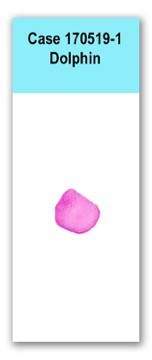Case 1 170519-1 (2236828-2)
Conference Coordinator: Charles Alex
//
Dolphin (age, sex, and species unspecified)
No clinical history is provided.
No gross description is provided.
Kidney: This slide has an approximately 1-cm-diameter section of a single reniculus, in which a broad, central zone of coagulative necrosis with associated hemorrhage and inflammation spans approximately 80% of the examined tissue. Throughout the necrotic debris, within arcuate arteries, and associated with peripheral regions of inflammation there are blunt segments of fungal hyphae that are characterized by negative-staining, bulbous to ribbon-like profiles. These vary from five to fifteen micrometers in diameter, with thin, undulating, non-parallel walls and some bulbous to conical tips. They lack septae, and occasionally branch at acute angles or perpendicularly. Subcapsular lymphatics are dilated and variably distended with mononuclear cells. Remnant tubules are hypereosinophilic with eosinophilic, glassy intraluminal material (interpreted as proteinaceous fluid). The tubular epithelium varies from attenuated to hypertrophied (interpreted as tubular injury with regeneration). Clumps of granular, dark brown pigment that is frequently associated with the fungal elements are scattered throughout the tissue. Glomerular podocytes are frequently rounded and extend into Bowmans space.
A Gomoes methenamine-silver stain demonstrated large numbers of hyphae, morphologically consistent with a zygomycete. Hyphae are scattered throughout the necrotic zone, throughout the interstitium, in Bowmans spaces of some glomeruli, and are occasionally associated with the walls of blood vessels including medium-sized arcuate arteries.
Kidney: Marked, acute, regionally extensive, necrotizing and pyogranulomatous nephritis with massive coagulative necrosis (infarction) and intralesional fungal hyphae (morphology consistent with the phylum Zygomycota)
This case is an example of the infarctive lesions that can typify fungal infections, and zygomycotic infections in particular, secondary to vascular injury. Most reported fungal infections in cetaceans are by Aspergillus or Candida species, which most commonly cause respiratory infections in these species. Zygomycotic infections are less commonly reported, but tend to be associated with a rapid clinical course with poor prognoses for survival. Vascular invasion, thrombosis, and tissue infarction with ischemic injury are typical features in these infections.
Zygomycotic infections were reported in a killer whale (Orcinus orca), two bottlenose dolphins (Tursiops truncates), and two Pacific white-side dolphins (Lagenorhynchus obliquidens) (Robeck and Dalton). Both cases in Pacific white-side dolphins had renal lesions with intralesional fungal hyphae, with vasculitis, vascular necrosis, thrombosis, and associated hemorrhage and ischemic necrosis. In both of these cases, skin, subcutaneous, and muscular lesions were presumed to represent the primary sites of infection, with subsequent hematogenous systemic dissemination. In humans, zygomycoses tend to affect immunodeficient patients, but some species can cause infections in the immunocompetent, most often in traumatized tissues.Higgins R. 2000. Bacteria and fungi of marine mammals: a review. Canadian Veterinary Journal. 41(2):105-116.
Robeck TR, Dalton LM. 2002. Saksenaea vasiformis and Apophysomyces elegans zygomycotic infections in bottlenose dolphins (Tursiops truncatus), a killer whale (Orcinus orca), and Pacific white-sided dolphins (Lagenorhynchus obliquidens). Journal of Zoo and Wildlife Medicine. 33(4):356-366.
Reidarson TH, McBain JM, Dalton LM, Rinaldi MG. 1999. Diagnosis and treatment of fungal infections in marine mammals. In: Fowler, M. E., and E. R. Miller (eds.). Zoo and Wild Animal Medicine. Current Therapy 4. W. B. Saunders Co., Philadelphia, Pennsylvania. Pp. 478–485.
Reidarson TH, McBain JM, Dalton LM, Rindaldi MG: Mycotic diseases. In: CRC Handbook of Marine Mammal Medicine. 2nd ed. Boca Raton, FL: CRC Press. 2001:337-353.

